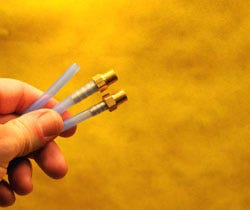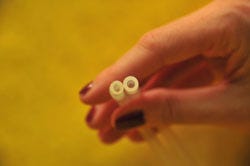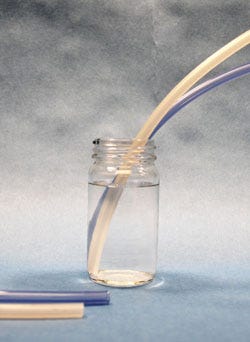Swell Solutions for Designing with Silicone
February 17, 2011
|
This photo shows a 1/8 × 1/4-in. translucent blue tube unmounted as well as mounted on 1/4-in. and 1/8-in. barb fittings. The tubes were subjected to a five-minute bath in the VMS swelling agent to expand the diameter sufficiently to easily mount to either fitting. |
Silicone has a longstanding history as being one of the most commonly used biomaterials in the healthcare industry. Due to silicone’s biocompatibility, it has been the material of choice for tubing or molded parts used in many medical devices. Silicone is offered in two primary forms—one catalyzed by platinum and the other by peroxide. Silicone catalyzed by platinum is the most common, but its tear and shear strength are weaker when compared with the peroxide version. Although one drawback to silicone is its poor tear strength, the physical properties of silicone—resistance to antimicrobial growth, low extractables content relative to other tubing materials, and easy sterilization—often make silicone a desirable choice in the medical device industry. However, working with silicone is not without difficulties. Design engineers are familiar with the challenges of attaching silicone tubing with barbed fittings, or mating molded silicone parts with complex geometries to hard plastic parts. Additionally, design requirements for multilumen silicone tubing with variations in wall thickness and material durometer can create significant assembly challenges on the production floor.
The consistency of silicone tubing is very flexible, like that of a rubber band. But unlike a rubber band, silicone tubing does not expand or stretch without mechanical or chemical help. This characteristic makes it difficult to fit the material over rigid parts. Also, silicone tubing has a tacky surface with a high coefficient of friction; when coupled with the lack of rigidity in its structure, trying to slide a silicone tube onto a fitting can seem downright impossible.
Although there are currently a number of different methods used to attach silicone parts to each other or to hard plastic or metal parts, one effective solution is using silicone swelling agents. These solvents are absorbed relatively quickly into the material, expanding the silicone to a desired dimension and allowing the silicone to easily accept the fitting or rigid part. Once the silicone is in place, the solvent evaporates, and the silicone returns to its original size, thus creating a tight and sturdy connection.
Volatile Methyl Siloxanes: An Overview |
Removing the typical limitations to parts and geometry associated with silicone frees designers to design without reservations. This is especially the case with products that are molded with both hard plastic and silicone, such as oxygen masks. Overall, silicone swelling gives design engineers more flexibility in their specifications.
Overview of Options
There are many different mechanical and chemical methods of joining silicone tubing or parts, and this article details the advantages and disadvantages of each (see Table I). Although the effectiveness of the option chosen is typically the most important factor, it is important to keep in mind the environmental properties and associated costs of the method. It is important to note that total cost goes beyond the up-front investment—labor, cleanup, and other time-related costs must also be accounted for.
Isopropyl Alcohol (IPA). One method for joining parts is using IPA to lubricate the silicone enough so that it will slide over a barbed fitting. IPA is inherently hygroscopic, in that it absorbs water. Note that this IPA is different from the rubbing alcohol found in drug stores, which is diluted. When used with silicone tubing, IPA is used in pure form. Some advantages to using IPA are that it is easy to obtain and it is relatively inexpensive. Many engineers who use IPA may not even know that other options exist because they always default to IPA as the most inexpensive option. Also important, especially when dealing with medical devices, is that IPA evaporates without leaving a residue. The main drawback to this method is that IPA does not dry quickly, which can translate into a time-consuming process, thus slowing down production and costing the manufacturer time and money. In addition, if the part is not completely dry when joined or when packaged, there may be some problems with the quality of the device down the line.
Silicone Oil. Another method is lubrication using silicone oil–based lubricants. This is a familiar method to engineers and is intuitive because using silicone fluid to join silicone ensures the materials’ compatibility. However, there are some major drawbacks to silicone oil. First, applying it can be messy. This problem is due to the nature of the oil, which never evaporates and is engineered to stay on a surface indefinitely. Silicone easily migrates to other surfaces, so if a manufacturer only wants to coat a specific portion of the device, it is harder to contain the fluid during coating. This can make the coating and joining process time-consuming because there is more cleanup required once the part is joined. There is also more risk of contamination during the coating process because the oil can attract and capture dirt and dust in the surrounding environment. The heightened chance of contamination still exists even when using a cleanroom. In addition, medical-grade silicone is more expensive than the lower grades that are used for other industries.
|
The difference between the dimensions of the original untreated tube (left) and a section of tubing that was in the bath for five minutes. Note that the dimensional swelling has increased the inner diameter of the treated tubing by 29% over the original dimensions. |
Silicone Swelling: An Overview
The process of swelling silicone to address the challenge of joining parts is still relatively unknown to many engineers who have traditionally used lubrication methods. Overall, the silicone swelling process is similar to when a sponge absorbs water. Like that sponge, the silicone tubing swells in size when it begins to absorb the solvent and then shrinks and recovers to its original dimensions once the solvent evaporates, resulting in a secure, tight-seal attachment to the barbed fitting or metal part.
|
Shown here are two silicone tube ends being treated in a small vial of the VMS swelling agent. |
Silicone swelling makes the process of attaching silicone parts or tubes with barbed fittings simple and quick. In fact, because the silicone only needs to increase in size by 1–2% in most cases, the entire swelling process can take less than one minute. First, the end of the silicone tube that is to be connected to the barbed fitting is dipped into a vessel of the swelling agent. The swelling of the submerged part or tube begins almost immediately. The amount of time that the tubing is in the solution determines how much it swells—and this can be timed accurately in high-volume operations to ensure that efficiency is maximized. Once the part is removed from the fluid, the swelling solvent immediately begins to evaporate, and as it evaporates, the part returns to its original state. The entire silicone swelling process—both to swell the silicone and then for the silicone to return to its original size—can be very quick when compared with other methods.
Hexane Solvents for Silicone Swelling
Silicone swelling provides several advantages over the previously mentioned methods. However, this method is not always the first that comes to engineers’ minds. This may be because one class of silicone swelling agents—hexane solvents—can have a higher up-front cost than options such as silicone oils or IPA. Also, hexane solvents are made of organic materials and are extremely aggressive solvents overall. Although they are very effective at swelling silicone, they also contain volatile organic compounds (VOC), which are regulated in many areas because they contribute to the formation of ground-level smog. VOCs are flammable and have a strong scent. Hexane solvents may remove ink markings on the parts, and they can also affect the elasticity of the material, possibly making it brittle or altering the physical properties of the silicone part.
|
This image illustrates the difference between untreated tubes (bottom) and treated tubes (top) after five minutes of exposure to the VMS silicone swelling fluid. |
VMS Technology
There are more environmentally friendly and higher-performing options for silicone swelling. Some providers are using a new technology that offers a class of solvents that utilize volatile methyl siloxane (VMS) technology, which has advantages over hexane silicone swelling agents (see the sidebar). VMS solvents are chemically similar to silicone tubing, which not only allows them to more effectively swell silicone, but also ensures that the physical properties of the silicone remain intact. In fact, the silicone completely recovers back to its original state once the fluid evaporates, with no impact on its physical attributes, such as elasticity.
|
VMS swelling fluid enables flexibility in assembling a single-size tube to different-sized barb fittings. |
Another major benefit to these solvents is that they evaporate quickly without leaving residue. Additionally, use of these solvents eliminates the VOC emissions associated with hexane solvents, which is a big factor for design engineers and manufacturers. There are currently vendors that can offer engineered fluids with improved environmental properties, meeting strict Environmental Protection Agency (EPA) regulations. A unique benefit to VMS solvents is their environmental compliance: unlike their hexane counterparts, they have an EPA-designated VOC-exempt status and also have an ozone depletion potential of zero. Although VMS solvents have not been around as long as hexane solvents and most engineers may not be aware of them, those who are have found great success with their use.
Conclusion
Silicone swelling with VMS solvents is an efficient, low-cost, and hassle-free method of joining silicone parts and tubing. However, VMS solvents are still relatively new to medical device engineers and manufacturers. With recent improvements in environmental properties, VMS solvents are an appropriate choice for overcoming the common challenge of joining silicone parts. For design engineers and manufacturers, silicone swelling with VMS technology provides design flexibility and an effective, efficient, and environmentally superior way to join silicone tubing or molded parts.
Jay Tourigny is vice president of operations at MicroCare Medical (New Britain, CT).
About the Author(s)
You May Also Like





.png?width=300&auto=webp&quality=80&disable=upscale)
